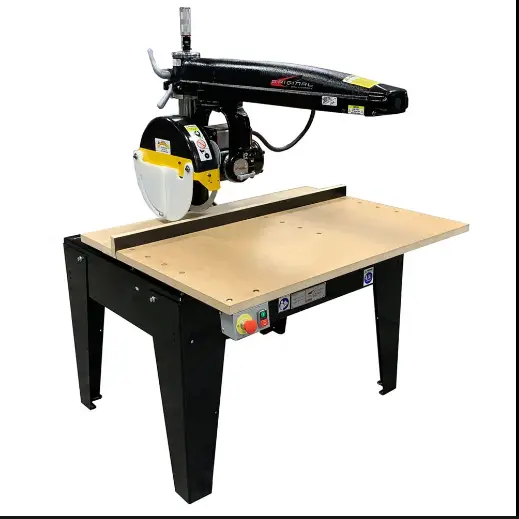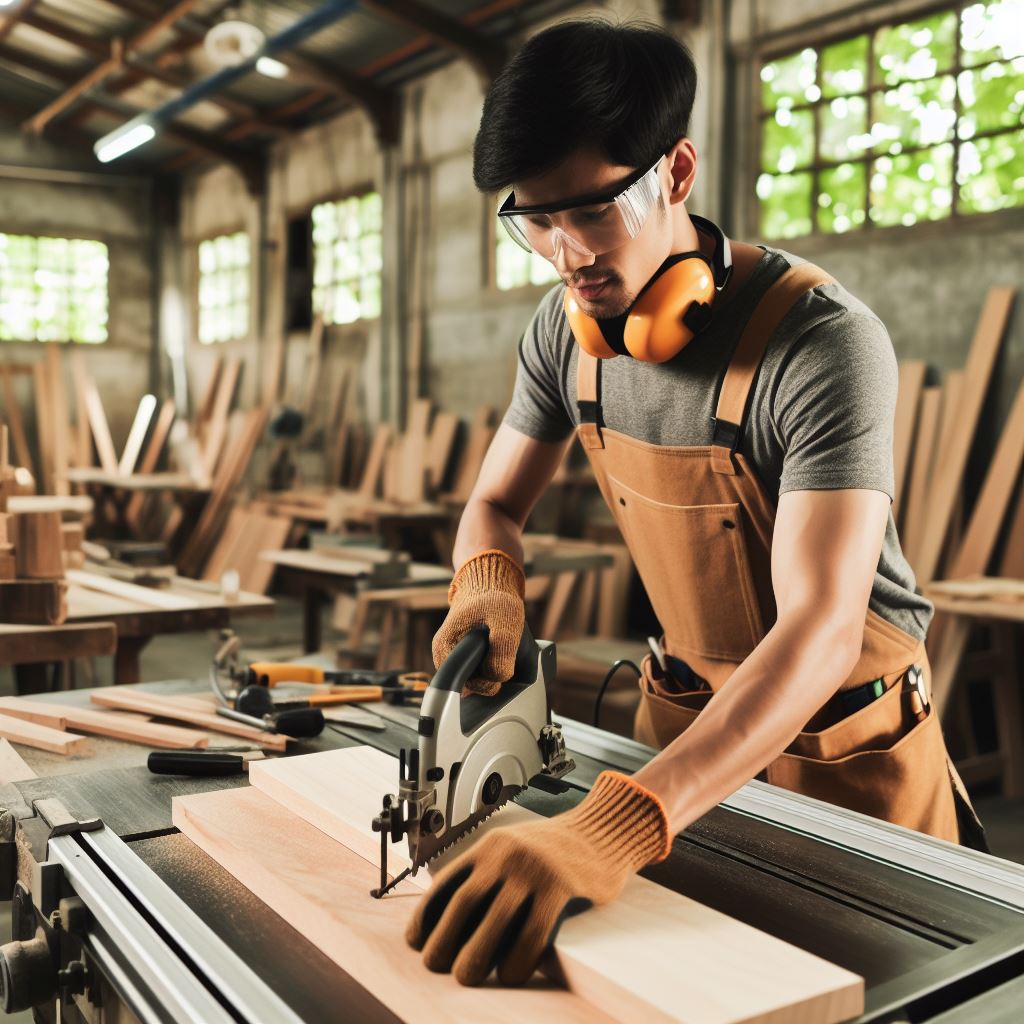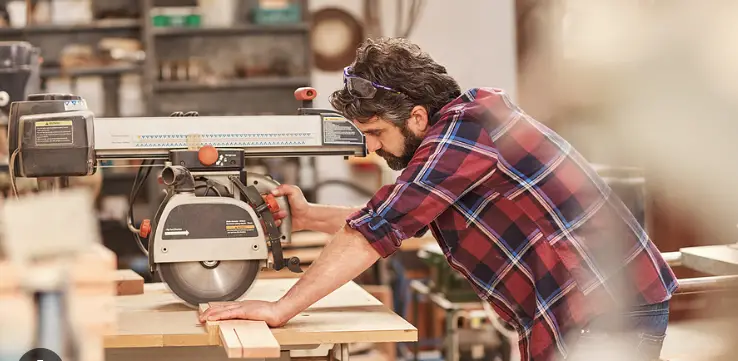Table saws and radial arm saws are two versatile woodworking saws found in many home shops and professional workshops for cutting wood stock. They share similarities but also key differences that impact their performance for various tasks.
So how do you determine whether a table saw or radial arm saw is the best option to meet your woodworking needs?
In this comprehensive comparison guide, we break down the pros, cons, typical usage cases, safety considerations and ideal user profiles of each saw type. After extensive testing and research into table saws versus radial arm saws, here are our main findings:
At a Glance Comparison Matrix
Before we dive deeper, here is an overview look at some of the key attributes differentiating table saws and radial arm saws in terms of their capabilities:
| Comparison Criteria | Table Saw | Radial Arm Saw |
|---|---|---|
| Speed of Operation | Faster, constant blade height | Slower, more adjustments between cuts |
| Cutting Precision | More precise, fixed blade path | Less precise without fixture setup |
| Consistent Angled Cuts | Requires stop block setup | Built-in beveling & compound miter control |
| Average Noise Level | 90-100 dB | 80-90 dB |
| Size of Material Cut | Range of sizes, larger material requires upgrades | Typically handles smaller stock more efficiently |
| Safety Considerations | Constant exposed blade path zone | Blade movement zone less consistently exposed |
Overall we’d summarize table saws as the faster, more precise tool for high volume general woodcutting. While radial arm saws allow more diverse cuts in a compact platform, but sacrifice some speed and precision by design.
Keep reading as we explore more factors around performance, use cases, safety and value comparisons.
Detailed Functional Breakdown: Table Saw vs Radial Arm Saw
While both classified broadly as “woodworking saws”, table saws and radial arm saws function quite distinctly to achieve different goals. Let’s examine key parts and core capabilities.
Mechanics Breakdown: Table Saw

Table saws consist of:
Circular Blade – Powerful 10-12” flat tipped carbide blade rotating upwards through table slot
Table Top Surface – Machined metal or cast iron surface with miter slot guiding fencing/jigs
Rip Fence Guide – Locking parallel guide arm ensures straight path parallel to blade
Miter Gauge – Adjusts angle of material feed into blade for angled cuts
Motor – Powerful induction motors from 1-5+ HP mounted underneath
Guard Assembly – Safety covers shielding blade exposure zone above and below table
Dust Collection – Integrated dust ports prevent microscopic airborne particles
In operation, users hold material stable atop the level table surface while feeding toward the fixed blade to perform primarily straight line rip cuts. Fence, miter gauge and aftermarket accessories expand cut type versatility.
Mechanics Breakdown: Radial Arm Saw

Radial arm saws consist of:
Sliding Arm – Horizontal beam anchored to vertical column allows Saw Head to slide back/forth
Saw Head – Contains 10-12” circular carbide tipped blade with integrated motor
Material Table – Stationary horizontal bed with extended fence for material positioning
Manual Crank – Raises/lowers Saw Head vertically for setting cut depth
Bevel & Miter Control – Adjustable pivot joints to angle blade for complex cuts
Stroke Control Lever – Engages powered Saw Head movement along beam to perform cut
Whereas table saws keep blade fixed bringing objects into it, radial arm saws slide a powered rotating blade mounted overhead through stationary material clamped below. Added pivot points unlock more potential cut versatility.
Now that we’ve explored the anatomy and functionality of each saw type, how do their attributes compare for real world woodworking?
Performance Comparison
With understanding now how table saws and radial arm saws operate to cut material differently, how do results and experience ultimately contrast? Let’s analyze major factors:
Speed of Making Cuts
Thanks to consistent blade height exposure and direct fence/miter guidance, table saws allow faster repeat rip cuts through multiple boards without adjusting positions. Just line up, push through and repeat.
In contrast, the nature of manually lowering blade depth, aligning multiple pivot angles, and sliding the radial Saw Head for each new radial arm saw cut consumes more steps between boards. Better suited for more specialized cuts in lower volumes rather than high quantity runs.
Cutting Precision
The inherent stability of table saw material laying flat atop a machined table surface with hold-downs lends well to highly precise cuts when setup properly. Fence alignment and miter slots maintain accuracy.
Radial arm saw precision however relies much more heavily on user technique. While cuts can be extremely accurate, slight angles misalignments as the overhead Saw Head traverses introduces more margin for subtle deviations without workpiece constraints. Precise cuts require more specialized fixture setups.
Blade Visibility
Table saws offer exceptional visibility as your workpiece remains static on the table while feeding into the blade. You can clearly see the blade make contact to avoid wandering.
The articulating radial arm transitions across your vision plane, often partially obscuring close blade proximity requiring more spatial awareness and risk analysis by feel as cuts are performed.
Convenience of Angled Cuts
Creating cuts at various angles requires table saws to carefully setup stop blocks and measure/test values – not intrinsically built-in.
Radial arm saws make dialing exact mitered, beveled and compound cuts far more convenient given integrated angle/rotation adjustments up to 60 degrees present right on Saw Head and slide arm components. Much easier adaptation.
Exposure to Flying Debris
The open nature of the spinning blade hovering just over the table expanse leaves table saw users vulnerable to flying wood chips or broken teeth. Good guards deflect some effects, but safety glasses are still a must.
Radial arm saw blade zone is constrained within the armature structure with just teeth tips extending through narrow slot, focusing cutting energy downward into the table bed. Less distribution of debris.
Now let’s move our comparison into examining ideal usage scenarios based on strengths…
Ideal Usage Cases
While table saws and radial arm saws tackle many shared cuts like crosscuts, rip cuts and basic mitering in the home shop, their differing attributes suit them better to certain applications.
Table Saws Ideally Suited For:

- High volume straight line rip cutting
- Precision components with strict length/width tolerances
- Cabinetry work where stable material support enables detailed joinery
- Dados, grooves, rabbets, etc using stacked dado blades
- Shop-wide integration as primary large material breakdown station
Radial Arm Saws Best For:

- Space-constrained shops needing horizontal storage footprint
- Expansive miter/bevel crosscuts for frames, decorative accents
- Adjustable clearance dado grooves for shelving/partitions
- Portable homeowner use benefitting from built-in mobility
- Smaller specialty material cutoff requiring dialed precision
For most shops performing large batch material breakdowns like dimensional planing, ripping plywood, and crosscutting studs, the optimized material handling stability and speed of table saws reign supreme.
But don’t underestimate the radial arm saw! For specialty angle manipulation tasks done in lower volumes with more selectivity, radial arm saws satisfy well as incredibly versatile machines occupying relatively compact footprints thanks to vertical rig mounting.
Now let’s move onto assessing key factors around operational safety…
Safety Considerations
Both table saws and radial arm saws demand extreme user awareness and respect when in operation to prevent severe injury risk. Their spinning carbide blades powered by high torque motors command proper caution. Let’s overview major elements:
Kickback Hazards
All saws present kickback risk – when friction catches rotating blades harshly flinging material back rapidly towards users. Always use stable infeed support and avoid forcing cuts in either tool.
But the overhead nature and articulated arm of radial saws allows greater freedom of movement increasing kickback variables. Table saws mitigate most uncontrolled factors with tabletop constraints.
Unprotected Blade Contact
Regarding direct body contact with exposed blades, table saws again feature continuous visibility and zone isolation around blade height making accidental contact easier to consciously avoid provided guards are kept installed.
The dynamic descending cut motion of radial arm saws brings hands potentially beneath the blade plane requiring depth spatial awareness. But limited teeth exposure concentrates risk zone.
Precision Alignment Needs
Setup mistakes also factor majorly into safety risks. Table saws rely heavily on fence/miter parallelism with blade to avoid climbing cut scenarios during passes. Radial arm saws need properly locked arm angles eliminating wander.
For both saw types, ensuring components don’t misalign over time maintains integrity eliminating accidents, but the radial arm saw relies more on regular re-validation of precise control across articulation points.
Material Control Differences
Related to alignment, the tabletop constraint of table saws provides superior solid workpiece control as the reference surface stays fixed, allowing hands to slidingly guide the load through cut.
Whereas radial arm saw cuts depend more on stationary hands while the powered Saw Head travels overhead, relying on solid fixturing and clamping to prevent any slippage or deflection sideways into the blade path.
Fatigue Risk Over Time
Additionally, the articulating nature of radial saw manipulation presents another variable absent in table saws – progressive fatigue over cutting sessions. As joint-dependencies and anchored leverage dynamics bear load, slight deviations magnify dramatically towards blade zone.
Table saws mitigate this by keeping hands static with machine (blade) doing the movement.
In summary – both saws command extreme presence when in operation, but table saws feature better inherent safety constraints compared to radial saw free range of motion.
Now let’s switch gears to assessing purchasing considerations like costs, accessories needs, and learning curves…
Purchase Comparison
If both the table saw and radial arm saw seem able to handle your cutting needs, how do ownership elements compare regarding value and planning requirements?
Power Source Options
Table saws offer both portable jobsite models running on loud jobsite generators/batteries along with traditional multi-horsepower industrial motors needing 220VAC hookups. Choose based on mobility needs.
Radial arm saws operate exclusively using 110V plug-in electricity – no portable or high amperage versions as compactness is inherent.
Learning Curve
The consistent material positioning of table saws lends well to intuitive understanding. Besides blade height/fence settings, steps fall into natural workflow and variables telegraph trouble easier making self-diagnostics organic.
Radial arm saws involve much more spatial translation between cut sequence steps and articulation interplay. Getting comfortable managing flexible head wandering takes time. More technique intensive with touch-oriented nuance to control vs process uniformity.
Costs Over Time
Upfront table saw investments cover a huge range from just over $100 for basic jobsite units to $5000+ for industrial cabinet saws. But included fence/miter gauge elements often suffice for most straightline needs. So while initial budget varies hugely, accessories costs remain reasonable for basic table saw functions.
Radial arm saws occupy a narrower $500-1500 standalone product price spectrum. However veteran users recommend investing in auxiliary precision fixture clamps and stops to fully optimize precision capacity from radial capabilities. So total budget over time sneaks higher.
Footprint Limitations
Classic full-size cabinet and hybrid table saws need significant stationary floorspace with stable underfooting able to handle 1500lb+ capacities including motors and table inserts. Jobsite saws compact only marginally for transportability compromises.
The consolidated, vertical oriented design of radial arm saws economizes significantly on space – needing only clearance for the sliding arm extension. Half the footprint is common.
So in summary – table saws sprawl but offer wider alignment forgiveness at varied budgets, while radial arm saws conserve room yet reward investments in rigidity through auxiliary gear for exploiting full precision.
User Temperament Compatibility
Beyond just application fit, perspective buyers’ personal working preferences and tolerances also determine suitability between these saw platform options.
For Table Saw Users Seeking:
- Heavy repetition cutting efficiency
- Consistent precision most cycles
- Confident dynamic cutting actions
- Process uniformity and control prioritization
For Radial Arm Saw Users Seeking:
- Stimulation tackling varied cutting angles
- Nuanced technique cultivation run-to-run
- Methodical positioning over force application
- Measurement, adjustment and alignment tolerance
Consider your values. Table saws favor consistency and output volume for confident hands-on learners valuing reliability. Radials invite exploratory problem-solvers and tinkerers comfortable adapting inputs around tool interactions seeking new puzzles rather than regimented perfection.
Neither better inherently – just different recipes of factors making each saw type satisfying depending on motivations. Consider your temperament tendencies here as well when choosing between these platforms.
Verdict: Which is the Better Saw Choice Overall?
So in conclusion, is one saw clearly better than the other? Or is it truly conditional depending on user goals?
The reality is…it depends! As we’ve illustrated throughout this comparison guide, table saws and radial arm saws both have highly competent strengths:
Table Saws: Exceptionally efficient material breakdown optimized for flat-laying stock pieces. Unbeatable for uniformity needs at high production rates.
Radial Arm Saws: Condensed Swiss Army knife able to tackle broader cutting angle challenges for finishing adaptability albeit at slower pace.
Rather than view one saw type always superior, instead consider scenario-specific needs:
- Tight on shop space? Radial arm saw.
- Crafting delicate furniture? Table saw.
- Frequently angled specialty cuts? Radial arm saw.
- Large batch production rip cuts? Table saw.
The good news is both platforms remain viable woodworking tools granting user creativity, accuracy and value. So analyze your usage cases, safety diligence and workflow temperaments to decide on the best saw investment matching your needs rather than inherently declaring one always better outright.
Bottom line – choose based on cutting versatility needs rather than assume table saws or radial models intrinsically superior in all situations.
Summarizing Takeaways: Radial Arm Saw vs Table Saw
| Consideration | Table Saw | Radial Arm Saw |
|---|---|---|
| Typical Usage Cases | High quantity rip cuts, uniform precision batch work | Multitude of angle cutting versatility in compact size |
| Safety Diligence Needed | Stricter blade zone awareness, alignment fidelity | Adapting safe free range articulation through zones |
| Learning Curve | Intuitive continuously variable processing | Multi-axis technique cultivation with spatial nuance |
| Costs Over Time | Broad initial purchase range, reasonable accessories | Narrower standalone cost, add precision fixtures |
| Temperament Fit | Consistent output rewarders, process devotees | Exploratory problem solvers, technique conquerors |
We hope this comprehensive radial arm saw versus table saw comparison provides clarity determining which platform makes the most sense for your workshop crafting pursuits based on usage needs, safety priorities, technique interests and budget. Both exceptional tools – just aligned to different woodworking requisites.
